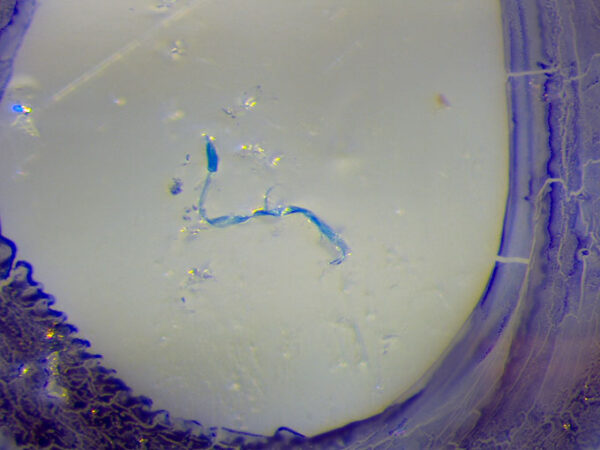Washing your jeans too much might pose risks to the environment
Denim microfibers found in lakes and the Arctic Ocean can carry harmful chemicals

Washing clothes loosens tiny fibers that flow down the drain and into rivers, lakes and oceans. Researchers recently found denim fibers in the Arctic Ocean, far from most washing machines.
Wachiwit/iStock/Getty Images Plus
Look at what you’re wearing. There’s a good chance it includes blue jeans or other items made from denim. At any moment, about half the world’s population is wearing this fabric. Tiny bits of denim have been adding up to a surprising amount of pollution in rivers, lakes and oceans, new research shows.
When it comes to denim pollution, says Sam Athey, one of the study’s authors, “We don’t know yet the impacts on wildlife and the environment.” But she is worried. “Even though denim is made of a natural material — cotton — it contains chemicals,” she points out. Athey studies sources of microfibers as a graduate student in Canada at the University of Toronto in Ontario.
Cotton fibers are treated with many types of chemicals, she notes. Some improve its durability and feel. Others give jeans their distinctive blue color.
Every time we wash clothes, microscopic string-like particles come loose. These microfibers flow out of washing machines, down the drain and into the world’s rivers, lakes and oceans. Many settle into the sediment at the bottom. Microfibers make up a lot of the smallest bits of pollution found there.
And many of those fibers are denim, Athey’s team reports.
They scanned sediment samples using a powerful microscope. Denim was obvious. Indigo in color, it had the unique twisted, but collapsed, string-like shape of the cotton.
Denim microfibers showed up in sediment from the Great Lakes, which straddle the border between the United States and Canada. More of these fibers polluted a series of shallow lakes in southern Ontario. They even turned up in sediment from the Arctic Ocean in northern Canada. Denim accounted for 12 to 23 percent of microfibers in the team’s sediment samples.
They found microfibers from other fabrics too. But the team focused on denim because so many people wear jeans.
Today’s jeans are colored with synthetic indigo dye. (Synthetic means it is made by people.) Some chemicals in the dye are toxic. Athey and her team worry about how far and wide these long-lived chemicals are spreading. “These fibers occurred everywhere we looked,” she says. “Urban and suburban lakes, as well as remote areas in the Arctic Ocean.”
The team shared its findings September 2 in the journal Environmental Science and Technology Letters.
Looking beyond microplastic fibers
Most research on environmental risks from the release of laundry lint has focused on plastic fibers. Often called microplastics, these fibers come from washing fleece and nylon fabrics.
These fibers are known to carry many chemicals into the environment. Scientists still don’t know how many of plastic’s ingredients might affect human health. But some, such as polyvinyl chloride, are known to cause cancer. Others are chemicals that mimic hormones. These can trigger unexpected changes in our cells’ growth and development. They can fake out our bodies’ normal hormone signals and lead to disease.
This helps explain why people have been paying attention to microplastics. But chemically treated natural microfibers, such as denim, might be just as worrying, says Athey.
Imari Walker Karega studies how plastic microfibers enter and affect water environments. She is an graduate student in engineering at Duke University in Durham, N.C., and was not part of the new study. But like Athey, she worries about the potential impact of the chemicals used to make indigo dye.
Smaller organisms, such as plankton, also could eat microfibers, Walker Karega says. Those fibers could block their digestive tracts, she notes. This would stop them from being able to eat the food they need to survive. “We just don’t really know all the effects of all microfibers as a class on our environment,” she concludes.

So many fibers
Athey and her team washed jeans to see how many microfibers each pair shed per wash. The answer? About 50,000.
Not all of those fibers make their way into the environment. Wastewater treatment plants capture anywhere from 83 to 99 percent of them.
Capturing 99 percent may sound pretty good. But one percent of 50,000 is still 500 fibers per wash sneaking through. Now multiply that times every pair of jeans that gets washed again and again. It still adds up to lots of microfibers entering aquatic environments. Plus, the way water-treatment plants capture fibers can be a problem. Some trap fibers with filters. Others let them settle out into the sewage sludge that builds up at the bottom of holding ponds. This sludge often ends up as fertilizer on farm fields. From there, rain can wash it into local waterways. So fibers may still end up in the environment.
“Everyone wears jeans so it could be our largest input of microfibers into our streams and soils,” Walker Karega says. “An easy way to limit that is by washing our jeans less often.”
Athey grew up thinking she had to wash her jeans after every couple of wearings. But most jean companies recommend washing them no more than once a month, she learned.
“The takeaway is not that you shouldn’t wear jeans,” she says. “We need to buy fewer clothes,” she says, and only wash them when they truly need it.







